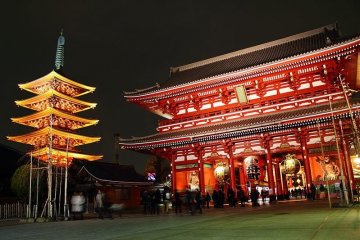One of the many draws to visiting Japan is having the opportunity to experience its rich and ancient culture. If that appeals to you, then make a plan a visit to Sensoji Temple in Tokyo's Asakusa District. This temple (which also goes by the name of Asakusa Kannon Temple) is Tokyo's oldest, originally built in the year 645 AD. Unfortunately, like so many structures in Tokyo, much of the ancient work was completely destroyed during World War II. However, the architecture of the modern temple is just as exquisite, and the culture and history can still be felt today.
In terms of architecture, Sensoji Temple has an abundance of intricately designed buildings which are beautiful both at a distance and up close. At the entrance to the main temple is the Hozomon Gate. Among other things, this gate is used to store special artifacts related to the temple. Adjacent to this gate is a beautiful five storied pagoda, which is also used to store various important items for the temple. Last but certainly not least is the temple hall itself. Most notably the main hall has a massive and steep roof which can be seen from a distance above other temple structures. As one would expect, the temple is considered a national treasure and is visited by people from all over the world each year.
Sensoji temple also has a variety of festivals and special events which take place throughout the year. During these times the small spaces around the temple can become very crowded. If you don't mind braving the crowds however, the experience is worth it. Among the yearly activities are the Sanja Matsuri in April, the Hagoita Market in December, and New Years festivities in January. At these events many visitors partake in the Buddhist customs around the temple grounds. One such custom is the spreading of smoke of incense over oneself, which is considered to purify, heal, and bring luck. Visitors can also buy small pieces of paper called omikuji, which have words of luck written on them - though be advised, not all of them are good luck!
While the temple grounds are fascinating, there is plenty of shopping to enjoy in the area as well. The path leading up to the temple is known as Nakamise Dori, and is lined with shops selling various items such as osenbei (Japanese rice crackers), Japanese fans and clothing, and of course typical tourist items like keychains and postcards. There are also many side streets which connect to Nakamise Dori, lined with shops and restaurants of their own.
Speaking of restaurants, if you're hungry when you visit Sensoji, there are options for all kinds of tastes here. Sushi, udon, yakitori, and a host of other delicious Japanese dishes are available nearby. Just explore, trust your nose, and you're sure to find a place that will hit the spot.
Another interesting aspect of a visit to Sensoji is that in the right spots, visitors can also view the new Tokyo Skytree. The structure is located only a few kilometers away across the Sumida River, and towers above almost everything in the area. Having such a modern marvel so close to a piece of Japan's history is a sight to behold, and convenient for anyone wishing to visit both while in Tokyo.
As you can see, Tokyo's Sensoji Temple is a must-see and well worth the trip. Between the architecture, history, culture, and tourist attractions, it's the perfect place to spend a few hours exploring and enjoying the wonder of Japan.









